ASRock DeskMeet B660 Review: An Affordable NUC Extreme?
by Ganesh T S on January 23, 2023 8:30 AM EST- Posted in
- Systems
- ASRock
- SilverStone
- SFF
- Mushkin
- Alder Lake
- B660
- DeskMeet
- Raptor Lake
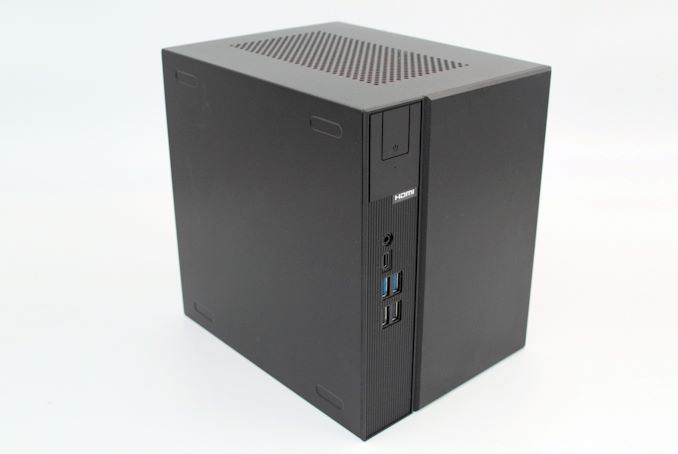
ASRock was one of the earliest vendors to cater to the small-form factor (SFF) PC market with a host of custom-sized motherboards based on notebook platforms in their Vision / Core series units. They ended up missing the NUC bus for the most part, with the Beebox series put into cold storage after Skylake and Kaby Lake were phased out. The industrial design and learnings from the Beebox have since been passed on to ASRock Industrial for systems catering to the commercial and embedded markets.
After Kaby Lake, ASRock shifted focus to Intel's 5x5 mini-STX form-factor introduced in 2015. While allowing for installation of socketed processors, the form-factor could not support a discrete GPU slot. Around the same time, Intel also started marketing enthusiast NUCs with a discrete notebook GPU soldered on the motherboard / integrated in the package. ASRock has introduced multiple Intel and AMD-based mini-STX DeskMini systems since 2016, and also created the micro-STX form-factor to offer a socketed alternative to the enthusiast NUCs.
Intel's next big push in the NUC market came with the appearance of Compute Elements and Extreme NUCs, with the latter supporting user-replaceable discrete GPUs. In order to offer alternatives in that segment, ASRock introduced their DeskMeet product line early last year with support for socketed processors and a PCIe x16 slot for installing add-in cards. The review below provides a detailed analysis of the features, performance, and value proposition of the DeskMeet B660 - a 8L SFF PC based on the Intel B660 chipset, capable of accommodating Alder Lake or Raptor Lake CPUs, and selected dual-slot GPUs.
Introduction and Product Impressions
The increase in the capabilities and power efficiency of processors, coupled with innovative thermal solutions has also enabled small-form factor machines to enter markets that were restricted to bulky power-hungry tower form-factor machines in the past. While a majority of the SFF and UCFF machines in the market are typically based on sub-45W processors, there is a growing market (in the gaming and workstation space) for small systems that can accommodate socketed CPUs. ASRock's DeskMini series of mini-STX and micro-STX machines have served this market since the Skylake days. Coinciding the with the launch of Intel's Alder Lake, ASRock introduced a new option for consumers in a slightly larger form-factor - the DeskMeet B660.
The DeskMeet B660 focuses on the DIY market for gaming and e-sports systems. This segment has served as a growth vector for the otherwise moribund PC market over the last several years. Portabile gaming PCs have the added advantage of being compact, lending themselves to use-cases that are not easily served by traditional tower desktops. Compared to the DeskMini mini-STX series, the new systems bring the following updates:
- PCIe 4.0 x16 slot allowing the installation of a dual-slot discrete GPU
- Increased memory capacity, thanks to the presence of four full-length DDR4 DIMM slots
- Integrated PSU
The package includes the following components:
- ASRock B660-ITX motherboard (with associated cables, screws, and an I/O shield)
- 500W (80+ Bronze) ATX PSU
- Metal chassis (168mm x 219.3mm x 218.3mm) (with associated assembling aids)
- Assembly instructions
Compact systems with a PCIe x16 slot and an integrated PSU can be realized with mini-ITX motherboards. Such standard boards are restricted to two DIMM slots due to space constraints. In order to accommodate two additional DIMM slots, ASRock has opted for a propretiary form-factor. Their 'Deep mini-ITX' board measures 210mm x 170mm (compared to the 170mm x 170mm of a regular mini-ITX board).
End-users have the flexibility to choose their own CPU, storage device, RAM, and optional discrete GPU. Space constraints impose some limitations on these, though. The 8L system can support liquid cooling if a PCIe add-on card is not used. CPU coolers up to 54mm in height can be used (anything higher would end up bumping into the underside of the PSU). Processors with a TDP of up to 65W can be safely used in air cooling. While select 125W TDP processors are supported, it requires the use of liquid cooling (ruling out the PCIe add-on card usability). F-series SKUs can be used, but it requires the compulsory installation of a video card, as the native display outputs of the B660-ITX require a CPU with an integrated GPU.
ASRock sampled us the DeskMeet B660 along with their AMD Radeon RX 6400 Challenger ITX video card and an Intel Core i7-12700F Alder Lake-S processor. The following additional components were used to complete the build:
- SilverStone Hydrogon H90 ARGB CPU cooler
- Mushkin Redline Frostbyte DDR4-3600 DIMMs (4x16 GB)
- Mushkin Vortex Redline 2 TB M.2 2280 PCIe 4.0 x4 NVMe SSD
The system is meant to be actively cooled, but the DeskMeet B660 unit by itself doesn't have any fans bundled with the chassis. The fans in the CPU cooler and video card cooler should suffice for most installations. However, the side of the chassis close to the PCIe slot can also be used to mount a 120mm case cooler or a liquid cooling radiator (thickness up to 45mm). In such cases, the PCIe slot is rendered unusable.
The full specifications of our review configuration are provided in the table below.
| ASRock DeskMeet B660 Specifications (as tested) |
|
| Processor | Intel Core i7-12700F Alder Lake-S 8C + 4c / 20T, 1.6 - 4.9 GHz Intel 7, 12MB L2 + 25MB L3, 65 W (PL1 = 65W, PL2 = 126W) |
| Memory | Mushkin Redline Frostbyte MRX4U360GKKP16G DDR4-3600 DIMMs 16-19-19-39 @ 3600 MHz (XMP 1.0) 4x16 GB |
| Graphics | AMD Radeon RX 6400 (Navi 24) 4GB GDDR6 (768 SPs @ 2039 MHz) |
| Disk Drive(s) | Mushkin Vortex Redline MKNSSDVT2TB-D8 (2 TB; M.2 2280 PCIe 4.0 x4 NVMe;) (Micron 176L 3D TLC; InnoGrit IG5236 Controller) |
| Networking | 1x GbE RJ-45 (Intel I219-V) |
| Audio | Realtek ALC897 (3.5mm Audio Jack in Front and Line In / Speaker / Microphone Jacks in Rear) Digital Audio with Bitstreaming Support over HDMI and Display Port (via dGPU) |
| Video | 1x HDMI 2.1 (up to 4Kp60, VRR and FRL) 1x Display Port 1.4a (both via dGPU) |
| Miscellaneous I/O Ports | 2x USB 2.0 Type-A (Rear) 2x USB 3.2 Gen 1 Type-A (Rear) 1x USB 3.2 Gen 1 Type-C (Front) 2x USB 2.0 Type-A (Front) 2x USB 3.2 Gen 1 Type-A (Front) |
| Operating System | Windows 11 Enterprise (22000.1335) |
| Pricing | (Street Pricing on January 23rd, 2022) USD 191 (barebones) US $863 (as configured, no OS) |
| Full Specifications | ASRock DeskMeet B660 Specifications |
Assembling the System
The DeskMeet package comes with the PSU and the motherboard bundled inside the chassis with appropriate padding. Assembling the system involves removing a single screw from the bottom side of the case and pulling out the motherboard tray. One of the likable aspects here is that the front panel of the case directly interfaces with the components on the motherboard. This eliminates the tangling of wires that was seen in the previous DeskMini systems when separating the motherboard tray from the chassis. The motherboard comes mounted on the tray, and the CPU and cooler installation steps are no different from other boards with socketed CPUs.
Up to four DDR4 DIMMs can be installed in the system. A M.2 2230 slot is available for a Wi-Fi / Bluetooth combo PCIe / USB card. The case has appropriate holes for the antennae. There are two M.2 2280 slots (one next to the PCIe slot, and another on the underside) for installation of NVMe SSDs. The slot next on the underside is PCIe-only, while the other can accommodate both NVMe and SATA SSDs. Unfortunately, the documentation is not clear on which of these slots is directly attached to the CPU. In other boards, the slot that multiplexes the SATA and PCIe lanes usually comes from the chipset (PCH), while the pure PCIe one is from the CPU. Based on this assumption, we reviewed the system with the SSD installed on the underside.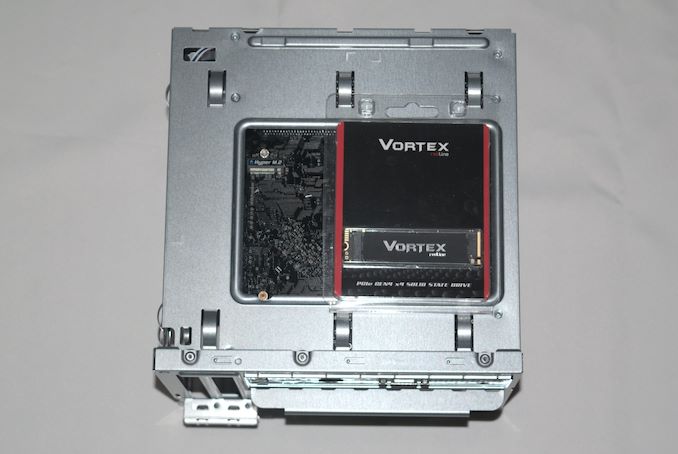
The board contains 3 SATA ports. The case allows for mounting of 2.5" and 3.5" drives in two areas. The first one is inside the inner frame, adjacent to the front I/O panel. While two 2.5" drives can always be installed in that area, a 3.5" drive can only be installed if the PCIe card is not full-length. The other area is the side of the frame near the motherboard's PCIe x16 slot. In this area, installing a 3.5" drive precludes the possibility of a PCIe add-in card. In the case of two 2.5" drives, dual-slot add-in cards can't be installed, but single-slot cards can still be used. Using such SATA drives also precludes the possibility of mounting a fan or a water-cooling radiator in the system.
GPU installation involves releasing a latch and fastening screws after placing the add-in card in place. The PSU is fastened in-place at the very end, with all necessary screws in the back panel. The PSU is not modular, but the number of cables to route is minimal, and cable management is not really much of an issue. It is possible to completely remove the motherboard and I/O shield from the tray, but we didn't find it necessary during the assembly process.
In the next section, we take a look at the BIOS options along with an analysis of the motherboard platform. Following that, we have a number of sections focusing on various performance aspects before concluding with an analysis of the value proposition of the system.


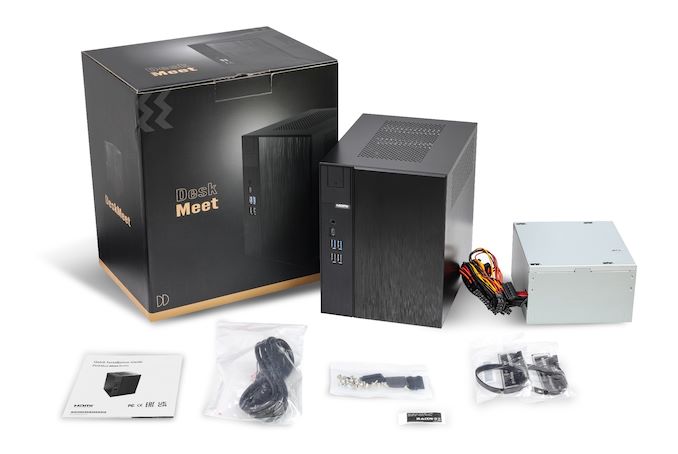

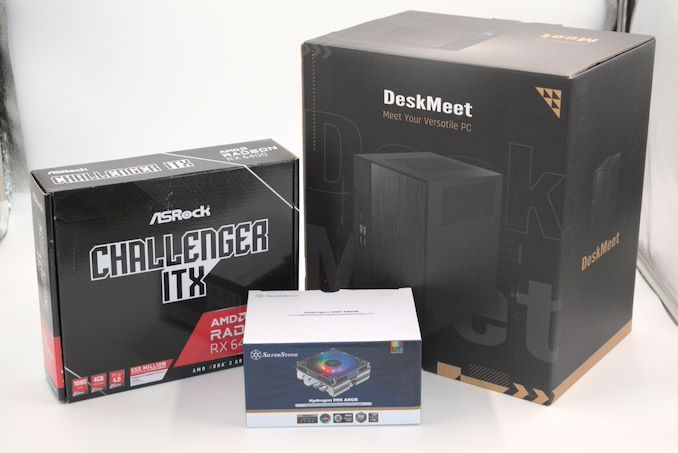
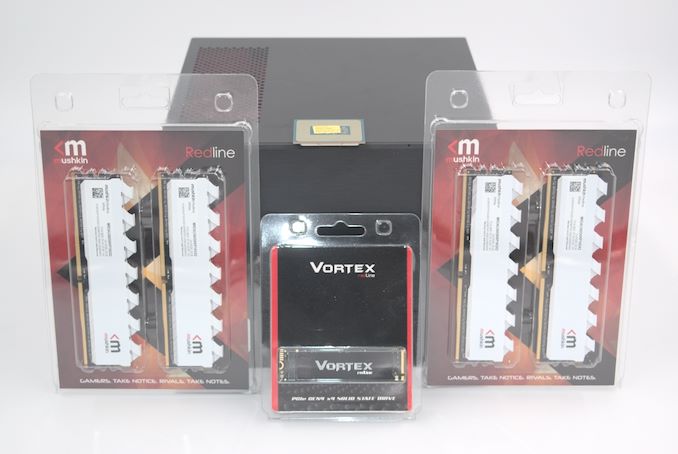














27 Comments
View All Comments
1_rick - Monday, January 23, 2023 - link
No pictures of the system with the GPU installed?megadirk - Monday, January 23, 2023 - link
I found one on their newegg listing under user review pictures. https://c1.neweggimages.com/itemreivewimages/revie...1_rick - Monday, January 23, 2023 - link
Thanks! I searched the site to find the rest of the images--the one showing the back panel doesn't have an add-in card installed at all. It looks like the card in your image is probably something like a dual NIC based on the shape of the metal boxes connected to the card backplane. I certainly hope that's not a GPU considering if it is whoever put that together would've had to take off the heat sink and hope a regular 120MM fan would cool it!ganeshts - Monday, January 23, 2023 - link
I will upload some more images in a gallery in the 'Assembling the System' sub-section later tonight. Yes, that image is not one of a GPU. If a GPU is installed, it becomes impossible to install the extra fan in the system. Even a single-slot GPU's cooling solution would interfere with the fan placement.With a single-slot GPU, two 2.5" drives can be installed in the place where the fan is seen. In the vertical orientation, the fan appears on top of the case.
With a dual-slot GPU, there is very little gap between the top of the case and the GPU's cooling solution. The GPU fan exhausts hot air directly out through the perforations on the top of the chassis.
ganeshts - Tuesday, January 24, 2023 - link
A gallery with pictures from the assembly process has now been added in the relevant section.The GPU is in the picture starting from https://www.anandtech.com/Gallery/Album/8223#31
1_rick - Wednesday, January 25, 2023 - link
Thanks, Ganesh.ballsystemlord - Monday, January 23, 2023 - link
@Ganesh Nice to see a Navi product being benchmarked. It's been a long time.RaiderJ - Monday, January 23, 2023 - link
I'm surprised they didn't go with a smaller ITX PSU. Seems like a simple way to reduce the size with minimal impact to cost/noise/heat.meacupla - Monday, January 23, 2023 - link
yeah, the back panel shows a mounting point for SFX PSUs. Asrock must have used an ATX for cost reasons.thomasjkenney - Monday, January 23, 2023 - link
Thanks, this is a good read."Unfortunately, the documentation is not clear from the documentation..."
You don't say? :)